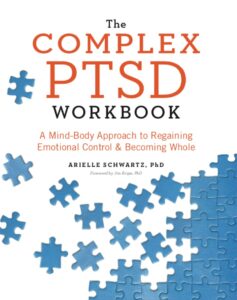
Effective trauma treatment requires a holistic way of addressing cognitive, emotional, and somatic symptoms. Traditional therapy attends to the cognitive and emotional elements of traumatic experience, the somatic experience is often left out of the room. EMDR Therapy uses a structured protocol for the treatment of post traumatic stress and related emotions, beliefs, and sensations. The traditional EMDR Therapy protocol already includes somatic awareness; however, interventions that enhance embodiment amplify body awareness in treatment.
“Therapists trained in the combined use of EMDR Therapy and Somatic Psychology have advanced tools to work with post traumatic stress. This post describes the importance of working within the “window of tolerance” to avoid re-traumatization in therapy. Read on to learn the difference between top-down and bottom-up processing. This post concludes with a practice of listening to your body for better self-care.”
Dr. Arielle Schwartz

Regulation focused interventions in EMDR Therapy help us work through traumatic memories without becoming overwhelmed or shut down in the process. To do so, we must work within the window of tolerance. The window of tolerance is a concept that was introduced by clinical psychiatrist Dr. Daniel Siegel and is a core component of somatic psychology trauma therapy. It refers to an optimal zone of nervous system arousal where we are able to respond effectively to our emotions.
When we are above the window of tolerance, we might feel hyperaroused with emotions of anxiety, overwhelm, or panic. This might look like defensiveness, anger, or agitation. On the other hand, when we are below our window of tolerance we might feel shut down, numb, disconnected, fatigued, or depressed. Here we might have difficulty setting boundaries or we can feel helpless. It is common for individuals with PTSD to alternate between the two extremes or to feel stuck on one side or the other. Dissociation can be understood as any feelings or arousal state that take us outside the window of tolerance.
Often clients can feel overwhelmed by EMDR Therapy and afraid that it would leave them feeling re-traumatized. However, working in the window of tolerance can help slow down the accelerated pace of processing creating a safe way of healing traumatic memories.
There are many ways to facilitate a safe and regulated approach to EMDR Therapy that prevents the risk of re-traumatization. One key to safe treatment is being knowledgeable about top-down versus bottom-up processing. Top-down processing involves the upper brain centers in the neuocortex which provide the us with increased access to self-regulation, reflection about symptoms, and a cognitive or narrative framework of traumatic events. Examples of top-down interventions include psychoeducation, mindfulness, identifying negative and positive cognitions, and increasing our resources. In contrast, bottom-up processing involves the lower brain centers in the limbic system and brainstem which helps us access emotional and sensory components of traumatic material. Bottom-up processing interventions come from somatic psychology and focus on body sensations, movement impulses, and emotions in a slow, mindful manner. Such processing provides us with an opportunity to release energy that got stuck during a traumatic event through shaking, trembling, or crying. In some cases, this process allows feels deeply satisfying and allows us to “digest” a traumatic event and discharge tension from the body.
Sometimes bottom-up processing can help manage hyperarousal by helping us focus solely on present-moment sensations as we drop the content of the traumatic material. However, bottom-up interventions may also cause flooding or overwhelm. Here, top-down interventions such as mindfulness or cognitive interweaves can slow-down processing and provide greater regulation during trauma processing. In sum, there is an ongoing and dynamic balancing of the regulating function of top-down processing and the accessing function of bottom-up processing that needs to be tailored to each individual.

The most important part of working within the window of tolerance is to track subtle body sensations and proceed slowly. When you are able to recognize the slight changes in your body, you can engage self-care resources before you get overwhelmed or shut down. For example, an early sign of distress might be a sense of slight irritability or growing restlessness. Maybe you observe that your breath has become shallow or that you are clenching your jaw.
When we ignore these body signals we are more likely to miss an important message or opportunity for self-care. For example, perhaps the initial distress is letting you know that a loud and stimulating environment is beginning to feel overwhelming. Or maybe you recognize that you haven’t eaten for several hours and your blood sugar is low. Perhaps your body is letting you know that you feel uncomfortable in a social situation and it is time to excuse yourself and say goodbye.
When we listen to the subtle cues from the body and mind we can honor the message by intervening with self-care. You can do so with this 4-point self-awareness practice:
These are all signals that you are leaving or are outside your window of tolerance. If you answered “yes” to any of these questions than it is important to bring in your resources for trauma recovery to reduce the likelihood of getting flooded or shutting down or to help you regain composure if you have already become overwhelmed.
Self-Understanding makes a difference. What are the early signs of dysregulation that indicate you may be moving outside your window of tolerance? What self-care resources work for you? In what way can you imagine using emotion regulation strategies before a situation becomes a crisis?

Connect to this post? The Complex PTSD Workbook, is now available on Amazon! Click here to check it out and increase your toolbox for healing. Whether you are a client or a therapist this book will offer a guided approach to trauma recovery.
Dr. Arielle Schwartz is a licensed clinical psychologist, wife, and mother in Boulder, CO. She offers trainings for therapists, maintains a private practice, has passions for the outdoors, yoga, and writing. Dr. Schwartz is the author of The Complex PTSD Workbook: A Mind-Body Approach to Regaining Emotional Control and Becoming Whole. She is the developer of Resilience-Informed Therapy which applies research on trauma recovery to form a strength-based, trauma treatment model that includes Eye Movement Desensitization and Reprocessing (EMDR), somatic (body-centered) psychology and time-tested relational psychotherapy. Like Dr. Arielle Schwartz on Facebook, follow her on Linkedin and sign up for email updates to stay up to date with all her posts.

Arielle Schwartz, PhD, is a psychologist, internationally sought-out teacher, yoga instructor, and leading voice in the healing of PTSD and complex trauma. She is the author of five books, including The Complex PTSD Workbook, EMDR Therapy and Somatic Psychology, and The Post Traumatic Growth Guidebook.
Dr. Schwartz is an accomplished teacher who guides therapists in the application of EMDR, somatic psychology, parts work therapy, and mindfulness-based interventions for the treatment of trauma and complex PTSD. She guides you through a personal journey of healing in her Sounds True audio program, Trauma Recovery.
She has a depth of understanding, passion, kindness, compassion, joy, and a succinct way of speaking about very complex topics. She is the founder of the Center for Resilience Informed Therapy in Boulder, Colorado where she maintains a private practice providing psychotherapy, supervision, and consultation. Dr. Schwartz believes that that the journey of trauma recovery is an awakening of the spiritual heart.